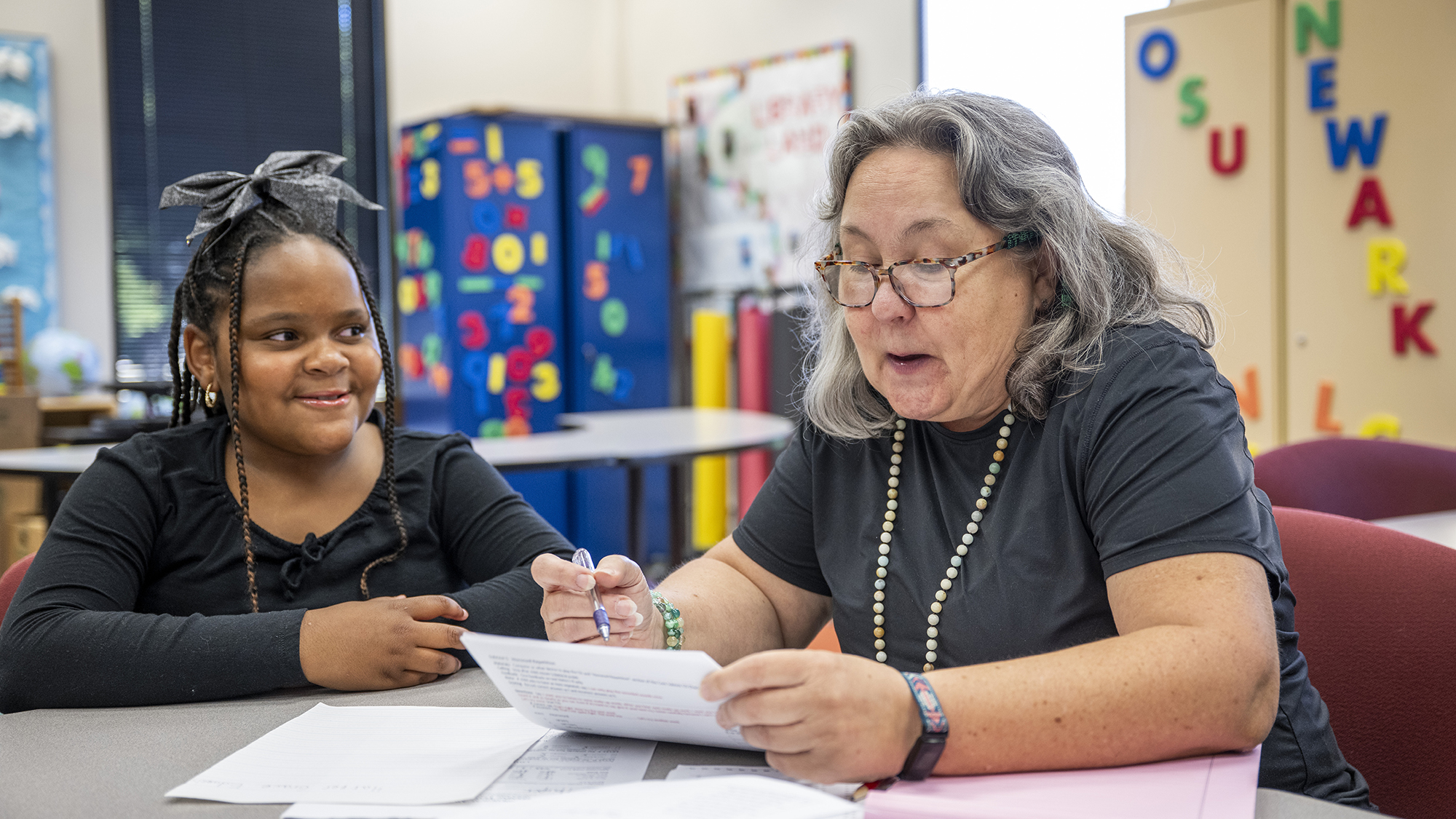Early screenings are unlocking young readers’ potential
Ohio State professor’s screenings help families detect dyslexia early
On a recent sunny fall day, Harper, a 9-year-old fourth grader, beamed with joy as she read aloud from a book while seated next to her mother, Ashley Edwards, at the kitchen island of their east Columbus home.
While the activity may seem like an ordinary one, reading with confidence is a hard-won accomplishment for Harper — one that took a lot of persistence from Edwards and support from The Ohio State University.
Harper’s reading has improved as a result of a screening that determined she has symptoms associated with dyslexia. The screening was conducted through a free service provided by Terri Hessler, professor of special education at Ohio State.
The screening confirmed Edwards’ concerns that arose when Harper entered kindergarten and began exhibiting issues with reading, such as difficulty differentiating between certain letters.
When Edwards expressed concerns to Harper’s teachers and school administrators, “they told me that she would grow out of it — it was a common thing for children her age,” Edwards said. “And then first, second grade. It was still happening into third [grade]. So then I was like, ‘Well, she’s not growing out of it, so what can I do?’”
Edwards, a service coordinator with the Franklin County Board of Developmental Disabilities, suspected her child may have been showing signs of dyslexia. Dyslexia refers to a cluster of symptoms that result in people having difficulties with specific language skills, particularly reading, according to the International Dyslexia Association (IDA).
The IDA estimates that 15% to 20% of the population experiences symptoms associated with dyslexia, such as inaccurate reading, poor spelling, poor writing or mixing up similar words.
Symptoms fall on a spectrum, ranging from mild to severe, said Hessler, who is also the parent of a child who has been diagnosed with dyslexia.
“The three primary risk factors are for phonological awareness, phonological memory and rapid naming. Phonological awareness is our ability to process the individual sounds in the language,” she said. “Phonological memory is our ability to hold phonological information in our memory and call it up and use it as needed in short-term situations.”
Rapid naming refers to the ability to identify symbols.
“Rapid naming is exactly what it sounds like — if you give a child a page of numbers and ask them to read the numbers as fast as they can,” Hessler said. “Individuals with dyslexia are often slower than individuals without dyslexia, and that can translate into slower reading.”
Harper said the difficulties she experienced sometimes made school frustrating. Certain assignments seemed impossible to complete, no matter how hard she tried.
“Sometimes it was hard, but sometimes it was easy, depending on what we were doing,” she said.
Since Harper wasn’t failing any classes, the school was hesitant to intervene and provide support services, Edwards said.
“We got her a private tutor, and she had tutors in the past, but they weren’t specific to dyslexia, so I don’t think it was helping her make the strides that she needed to make,” she said. “But once we understood what she needed, I think that’s what helped her get on track.”

Dyslexia screening made the difference
Hessler began offering free dyslexia screenings at Ohio State Newark in advance of a state law that went into effect a couple of years ago. A change to the Ohio Revised Code mandated that beginning in the 2023-24 academic year, every school district statewide must screen every kindergarten student for dyslexia, according to Disability Rights Ohio.
“I wanted a solid way to help schools be able to identify and get help for kids who have the risk factors for dyslexia,” Hessler said. “A lot of parents saw that kindergartners were mandated to be screened for dyslexia, and their kids were older than kindergarten, and so there wasn’t anything for their students. A lot of the requests I got were from kids in second grade and older, all through high school and adults.”
Hessler holds a Certified Master Trainer – Institutional Level credential from Orton-Gillingham International in a specialized teaching approach to address dyslexia.
“I continually update my knowledge by going to the International Dyslexia Association Conference,” she said. “I just recently got the test of dyslexia, which is a brand new test that’s much more involved than the standardized test I’m using now. I’m working my way through that, learning how to implement that test, too. I am always improving my knowledge in this area.”
Though the state law went into effect too late to provide Harper with a mandatory school-based dyslexia screening, Edwards was determined to get her daughter the help she needed.
She found Hessler’s service through a referral from the Dyslexia Center of Columbus. Hessler conducted an hour-long screening with Harper in March 2025.
“She had me spell words and read back nonsense words to her,” Harper said.
The screening turned out to be invaluable, Edwards said.
“Dr. Terri was free first and foremost, so it saved us about $3,000. That’s the quote that I got for a doctor, a neuropsychologist,” a cost that would not have been covered by insurance, Edwards said. “Dr. Terri taking the time out of her day … to assist us and other families was a huge blessing.”

Early intervention is key
At the conclusion of each screening, Hessler provides participants with a detailed report listing what their likely deficits are, how those deficits would be best remediated and any accommodations that might help them succeed.
Edwards submitted Hessler’s report to teachers and administrators at Harper’s school. The report served as definitive proof that Harper was in need of accommodations.
“If I did not mention it to her teachers or seek Dr. Terri out, I don’t believe Harper would have the resources,” Edwards said. “She wouldn’t get the additional time for her testing, including state testing. Right now, she has the accommodations at school with her spelling words. She only has to do half of the list, versus the whole list, and special time to take her tests. Advocacy is definitely important.”
Harper said the accommodations have not only helped her with her assignments, but also made her enjoy school more overall.
“I don’t feel as frustrated,” she said. “I got more help, and it worked.”
Research has found that early identification of dyslexia and targeted remediation can reduce the potential negative impact, according to the IDA.
“It means change, it means breakthroughs, it means additional resources for our children,” Edwards said of Hessler’s dyslexia screening service. “Ohio State has helped us break down barriers, and we appreciate Dr. Terri and Ohio State for the opportunity.”
Hessler said she finds personal and professional fulfillment in helping people of all ages who exhibit risk factors for dyslexia to get the support they need.
“It’s important to me to provide free services because diagnostic evaluation is prohibitively expensive to many families in our state — if not most families in our state,” she said. “I can provide a free screening and then based on my expertise and experience in dyslexia intervention, I can recommend what any given child needs in order to help them become a better reader.”



